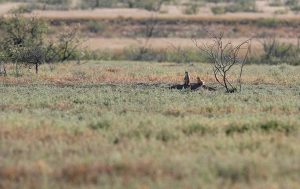He kept it up until I moved off and then changed his tune. Soon, prairie dog heads started popping up everywhere. Within a few minutes they were back out, running from burrow to burrow, digging in the grass and chattering away. Just another busy day in prairie dog town.
Prairie dogs resemble a fattened squirrel with a short spiked tail. They live in large communities that spread for acres on the shortgrass prairie, building circular dirt mounds around the entrances to their burrows. I definitely saw a prairie dog disappear down one entrance and pop up a short while later in another, so at least some of them are interconnected.Most wildlife tends to be active at dawn and dusk, but prairie dogs sleep late and go to bed early, doing most of their running about in the heart of the day.
I ran across a lot of prairie dogs on a recent trip through the Texas Panhandle – at both Caprock Canyons State Park and Muleshoe National Wildlife Refuge. They were Black-tailed Prairie Dogs – the most common species – the tip of whose wiggly tail appear to be dipped in black paint.
Prairie dogs are vegetarians, living on grass, roots, seeds and flowers. The prairie dogs I watched at Caprock Canyons would rummage through the grass, then sit up to gnaw on a root that they grasp in their delicate paws.
On the other end of the food chain, they are prey for hawks, coyotes, bobcats and badgers. The approach of a coyote near a prairie dog town on the Muleshoe refuge prompted the entire colony to sit up and take notice, but it didn’t induce the blind panic caused by my arrival.Prairie dogs are social animals organized into large families, which are grouped into neighborhoods, which join into sprawling prairie dog towns. The largest on record – one in West Texas – reportedly covered about 25,000 square miles and was home to as many as five hundred million prairie dogs. I found a lot of references to it but none that mentioned exactly where it was located and when.
I came across my first prairie dog town shortly after a heavy rain, and a lot of home repairs were under way. The prairie dogs were digging fresh dirt out the top of their burrows and padding them with dry grass. Apparently, prairie dog towns have prairie dog homes with bedrooms, bathrooms and nurseries.


